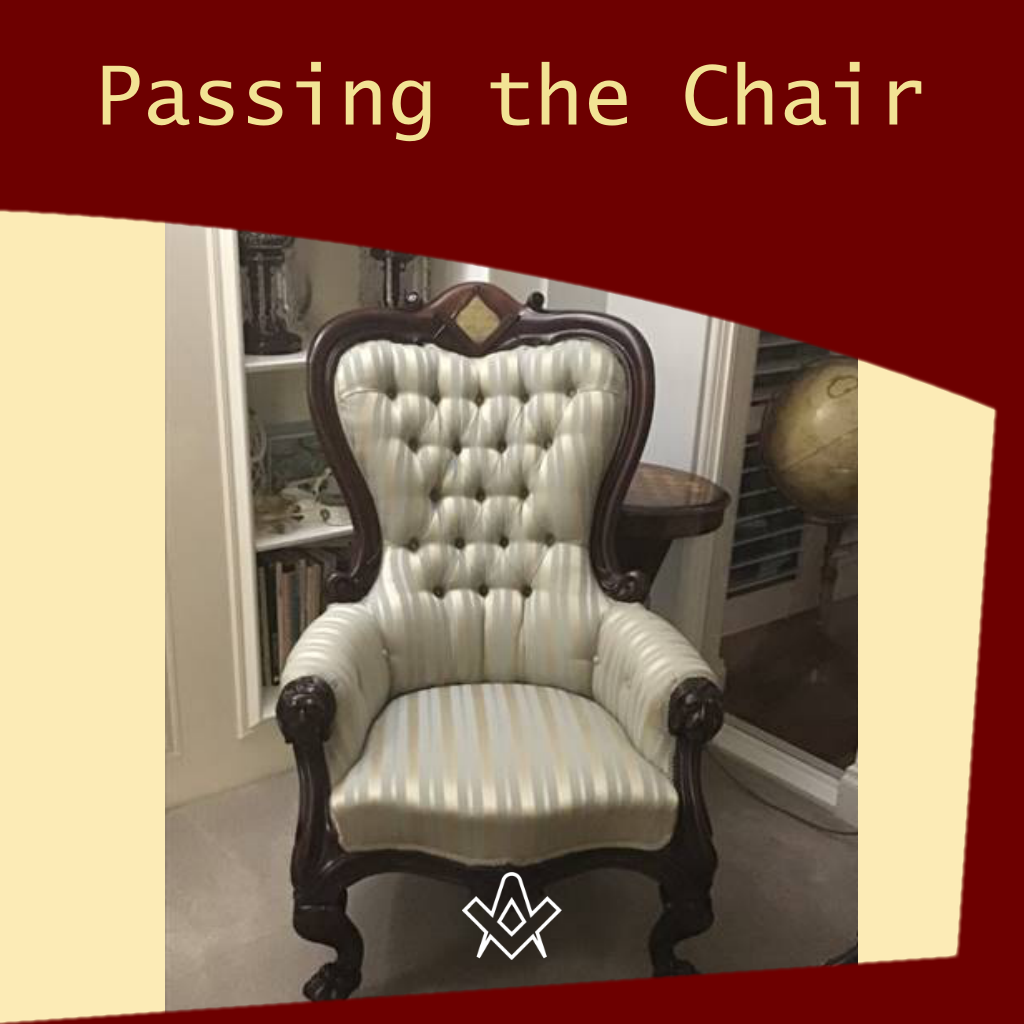W.Bro. Paul Gardner looks at a mid 19th century artefact and ponders ‘Chairing’
The story begins with this chair turning up in Australia when recently the owner had it refurbished only to reveal a previously unseen plaque.
He had bought the chair along with other antique furniture in an auction when domiciled in London in the 1960s whilst training as a medical doctor.
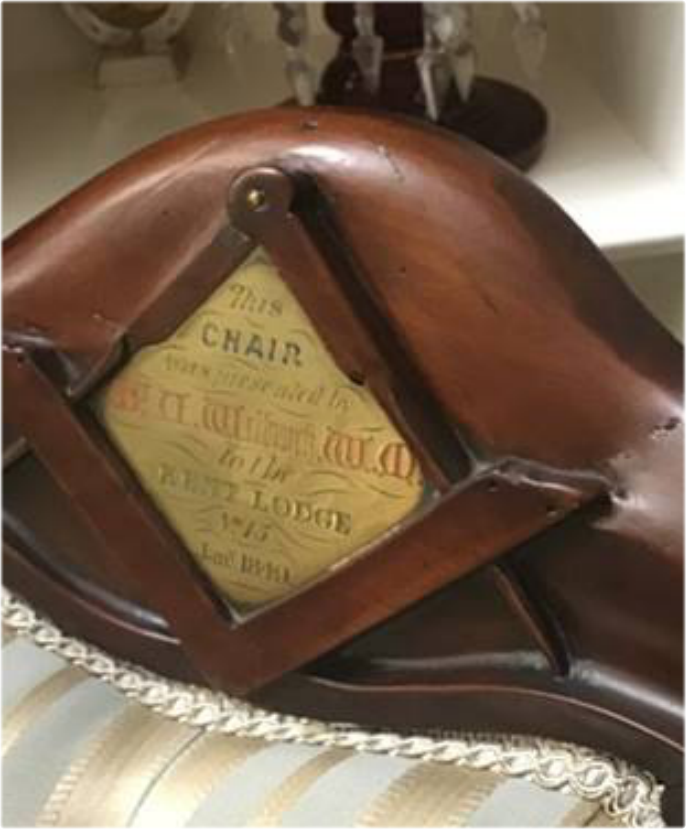
This CHAIR Was presented by Br H Welbrook WM(I) to the KENT LODGE No15 Jan 1849 –
IMAGE CREDIT: Paul Gardner
Delving into Kent Lodge’s history it was confirmed Bro. Welbrook reached the Chair of King Solomon in the year 1849 and endowed the Lodge with this chair to mark the occasion.
In those far off days many lodges meeting in hostelries had their own ‘tools’ and furniture and it went from venue to venue with them.
At the time they met at Gerrard’s Hall, Basing Lane, London, moving to the Bridge House Hotel two years later.
Between 1800 and 1900 they had thirteen places where meetings were held. A history note of February 1869 relates on the move to the Guildhall Coffee House:
‘That the Tyler be empowered to remove the Lodge furniture forthwith’
According to Bernard E Jones FREEMASONS’ BOOK OF THE ROYAL ARCH it was originally expressly laid down in Rule 6 that the Candidate for the R.A. must have attained three progressive degrees; have passed the chair; been registered in the Grand Lodge books, as a Master Mason, for twelve months at least.
Then, approved on examination by one of the Grand Chiefs or Grand Scribes, to ascertain which certificate must be given and signed in open lodge and further attested by the Grand Secretary. But this was to change…..
Bridging the eighteenth and nineteenth centuries none but Installed Masters were acceptable as Candidates for the Royal Arch.
Passing the chair was a device originally designed for the one purpose of giving the Master Mason who had not ruled a lodge the status qualifying him as a Candidate.
Originally, it is believed, it was introduced by the Antients, but was soon adopted by the Moderns.
This probably took the form of installing the Third Degree Mason in the Master’s Chair, then facilitating his leaving the chair quickly thereafter.
Whatever the practice became in the course of a few years, it is quite clear that under the rules of the first Grand Chapter (1766) it was not necessary for the Candidate to be of higher rank than Master Mason.
Neither these rules nor those given in the Charter of Compact required or could require the Candidate to be a Past Master.
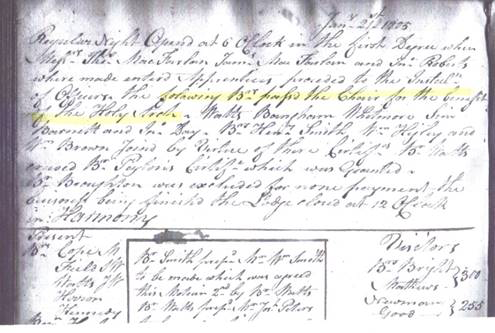
Regular night opened at 6 O’clock in the first Degree where Bro and Bro were made entered Apprentices proceeded to the Installation following Bros pass’d the Chair for the benefit of the Holy Arch.
However, the Candidate may have passed the chair previously in his Craft lodge or, if on the evening of his Exaltation, either in his Craft lodge or in a lodge especially opened by the members of the chapter.
This entry in an old minute book of 1805 confirms the practice albeit a Monday. Interestingly this was often performed on a Sunday, a meeting day outlawed some years later.
When the Chapters became independent, the regulation could not be abolished, for that would have been an innovation.
A candidate for the Degree of Royal Arch by Virtual Past Master degree (Chairing) before his exaltation under the English Constitution was forbidden in 1826.
The Committee appointed to formulate Regulations worked quickly and presented a draft to Grand Chapter on 15 April 1817.
They were accepted and set the seal on the future arrangement and development of the Grand Chapter.
They also marked the new relationship between the Craft and the Royal Arch and the interdependency of the two.
Times have changed and adjustments made and in the modern era a clarification of the status with some relaxation envisaged by a working party which reported in 2003.
The proposed wording to be placed before Grand Lodge for approval in December states that:
“At the Quarterly Communication of 10th December 2003 the United Grand Lodge of England acknowledged and pronounced the status of the Supreme Order of the Holy Royal Arch to be ‘an extension to, but neither a superior nor a subordinate part of, the Degrees which precede it’.”
It is not suggested for one moment that this removes outright the effect of the famous ‘fudge’ of 1813.
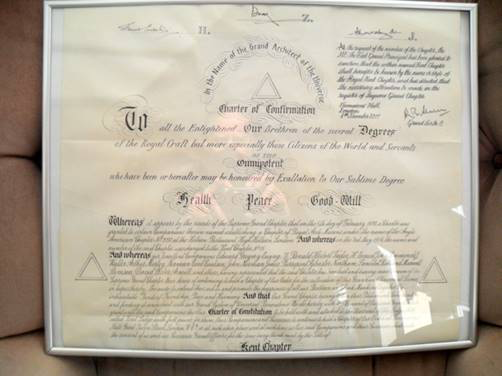
Chapters were to be no longer independently chartered but were to be sponsored by a Lodge, to whose warrant the Chapter was to be attached, and whose number and, later, name they were to bear.
Chapters with charters from the original Grand Chapter were to return those charters in exchange for a Charter attaching them to a Lodge of their choice.
History needs to be constantly updated and recorded and in 2016 Kent Lodge re-adopted its early title of ‘Royal Kent Lodge No15’ by the approval of the Grand Master following a decade of research into its unbroken history.
The Royal title was originally used in 1816, so named after the Duke of Kent, the Grand Master of the Antients at the time of the Union.
It fell out of use after 1820 when the Duke died. The associated Chapter likewise was permitted to change its title a year later.
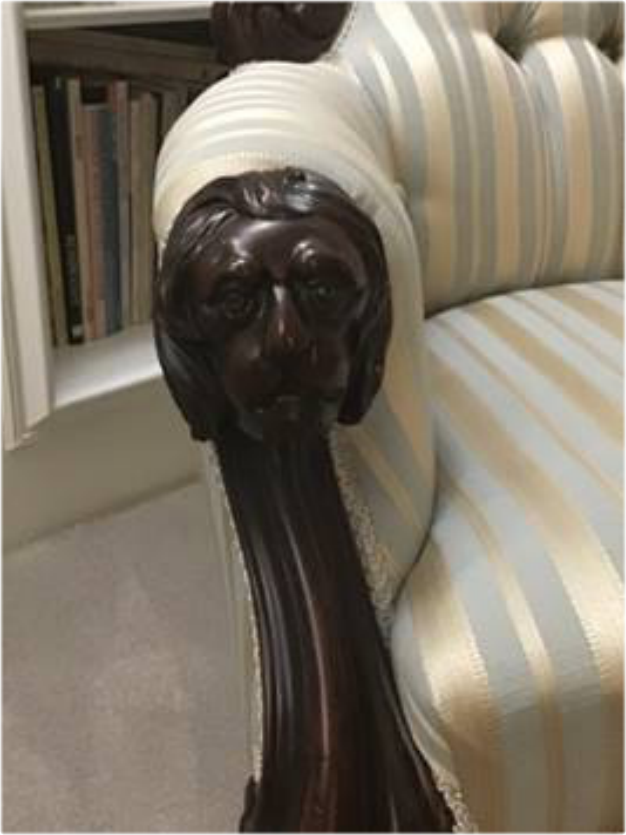
Apparently, the matter can be summed up in this way. All Antients’ Royal Arch lodges and chapters required Candidates to have passed the chair, actually or virtually, and a number of Moderns’ chapters did the same, but certainly not all of them.
A necessary event, extant into the 19th century, to complete a mason’s journey into Antient Freemasonry,
Although a long gone practice it would be tantalising to think that this chair could have been used for such purposes by Kent No.15. An Antient lodge with continuous working and a lion’s spirit since 1752 !
Article by: Paul Gardner

Paul was Initiated into the Vale of Beck Lodge No 6283 (UGLE) in the Province of West Kent, England serving virtually continuously in Office and occupying the WM Chair on three occasions.
Paul joined Stability Lodge No 217 in 1997 (UGLE) and now resides with Kent Lodge No 15, (UGLE) the oldest Atholl Lodge with continuous working since 1752, where he was Secretary and now Assistant Secretary and archivist, having been WM in 2002.
In Holy Royal Arch he is active in No 15 Chapter and Treasurer of No 1601, which was the first UGLE Universities Scheme Chapter in 2015.
He was Secretary of the Association of Atholl Lodges which maintains the heritage of the remaining 124 lodges holding ‘Antients’ Warrants and has written a book on Laurence Dermott. - https://antients.org
Recent Articles: by Paul Gardner
 Exchanged the Sceptre for the Trowel Explore the intriguing history of Royals and Freemasonry following the new Monarch's Coronation. From Prince Albert's initiation to the influence of George II and beyond, discover why royalty has long exchanged the sceptre for the trowel, shaping society and maintaining power through this ancient craft. |
 Unearth the mystic origins of Freemasonry in 'That He May Be Crafted.' Paul Gardner explores the symbolic use of working tools from the earliest days of this secret society, revealing a time when only two degrees existed. Delve into this fascinating study of historical rituals and their modern relevance. |
 Paul Gardner looks to a time when politics and Masonry were not precluded, but shush! This was London Masons and the Spitalfields Act of 1773-1865. |
 That rank is but the guinea’s stamp, the man himself’s the gold. But what does this mean, even given the lyric and tone of Burns’ time? It is oft times used in a derogatory sense, (somewhat in good humour) between Masons (or not) on the achieving of honours. But its antecedents are much more complex than that. |
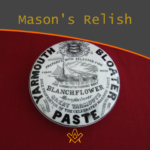 John and Timothy Coleman Blanchflower were initiated in Walpole Lodge, No. 1500, Norwich England on 2 December 1875; noted as a purveyor of ‘sauce’ to masons! |
 Jacob’s Ladder occupies a conspicuous place among the symbols of Freemasonry being on the First Degree Tracing Board, the most conspicuous and first seen by the candidate on his initiation – a vision of beauty and intrigue for the newly admitted. |
 During a detective hunt for the owner of a Masonic jewel, Paul Gardner discovered the extraordinary life of a true eccentric: Dr William Price, a Son of Wales, and a pioneer of cremation in Great Britain. Article by Paul Gardner |
 Paul Gardner tells the story of his transition from one rule book to another – from the Book of Constitutions to the Rule Book for Snooker! |
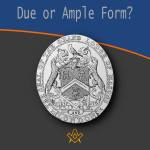 Due or Ample Form? What is ‘Ample’ form, when in lodges the term ‘Due’ form is used? |
 The Butcher, the Baker, the Candlestick Maker Paul Gardner explores the Masonic link between provincial towns’ craftsmen, shop keepers and traders in times past. Many remain in the modern era and are still to be found on the high street. |
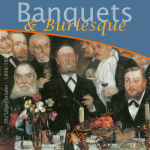 Masonic dining and banquets, at least for the annual Investitures, were lavish, and Kent Lodge No. 15, the oldest Atholl lodge with continuous working from 1752, was no exception. |
 The ‘cable-tow’ or ‘noose’ is used in Craft Masonry as part of the ritual, as are ropes and ties in other degrees - but what does it symbolise? |
 Paul Gardner reflects on those days of yore and the “gentleman footballer” in Masonry |
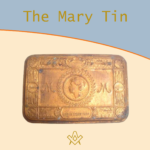 What is the Masonic connection with the 1914 Christmas Mary Tin |
 That Takes the Biscuit - The Patriot Garibaldi Giuseppe Garibaldi Italian general and politician Freemason and the Grand Master of the Grand Orient of Italy. |
 W.Bro. Paul Gardner looks at a mid 19th century artefact and ponders ‘Chairing’ |
masonic knowledge
to be a better citizen of the world
share the square with two brothers

click image to open email app on mobile device



